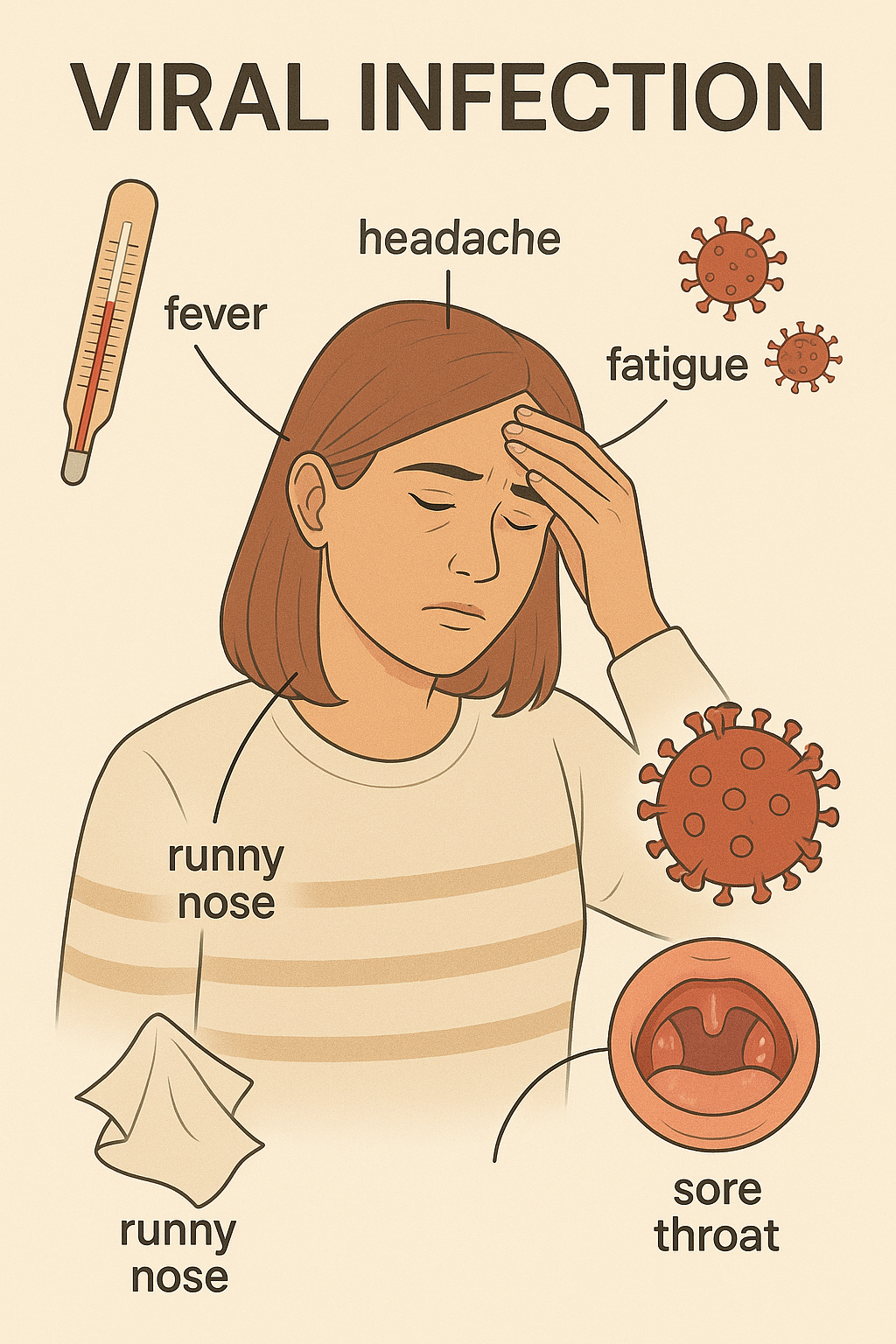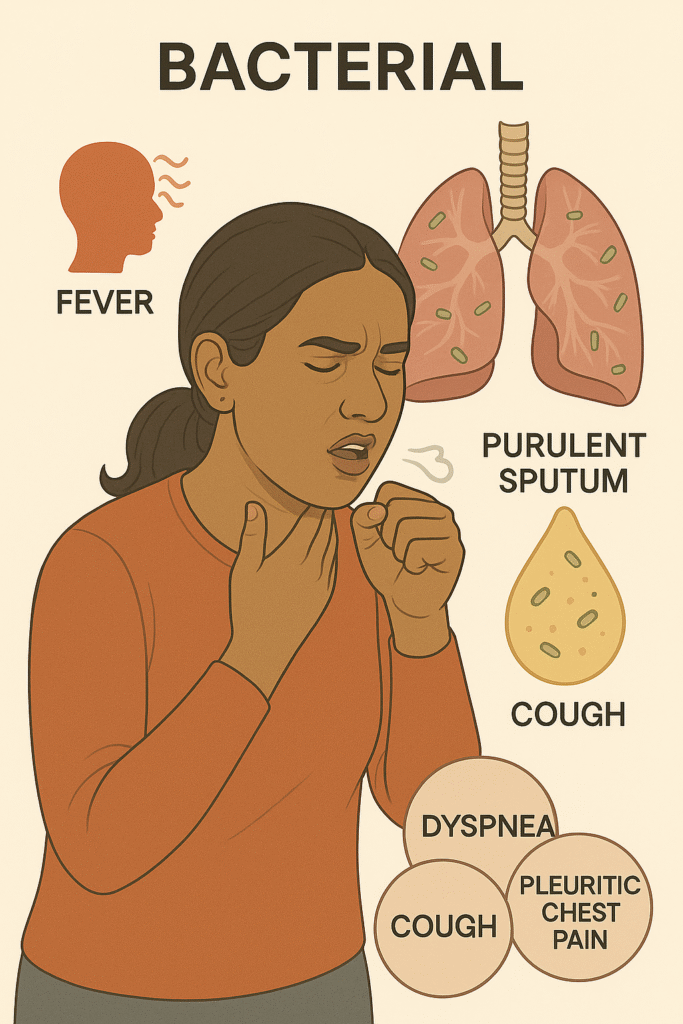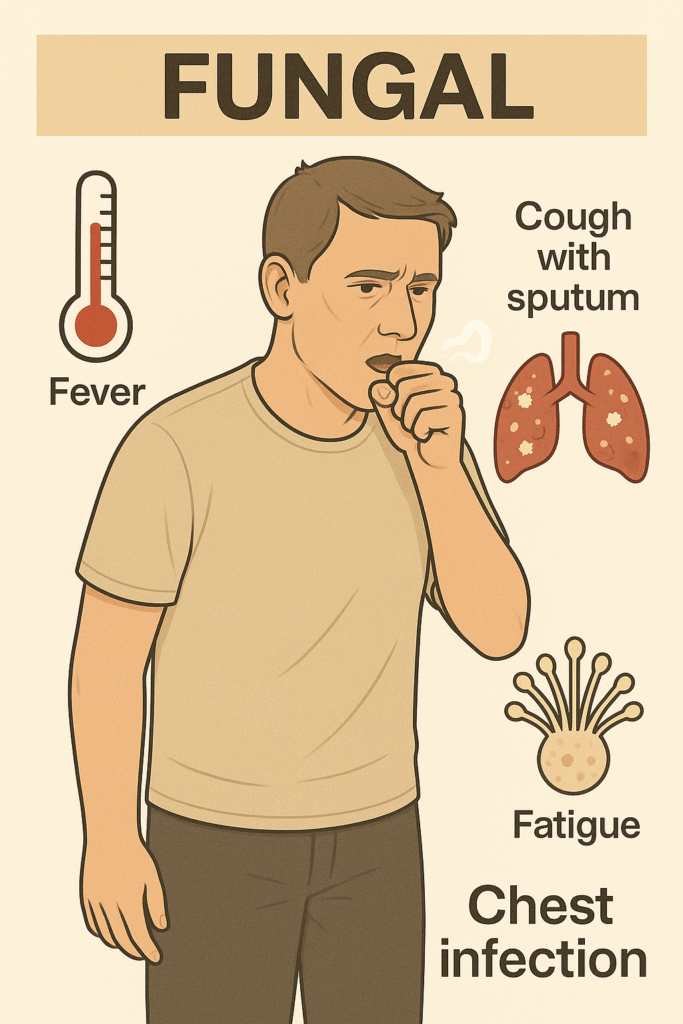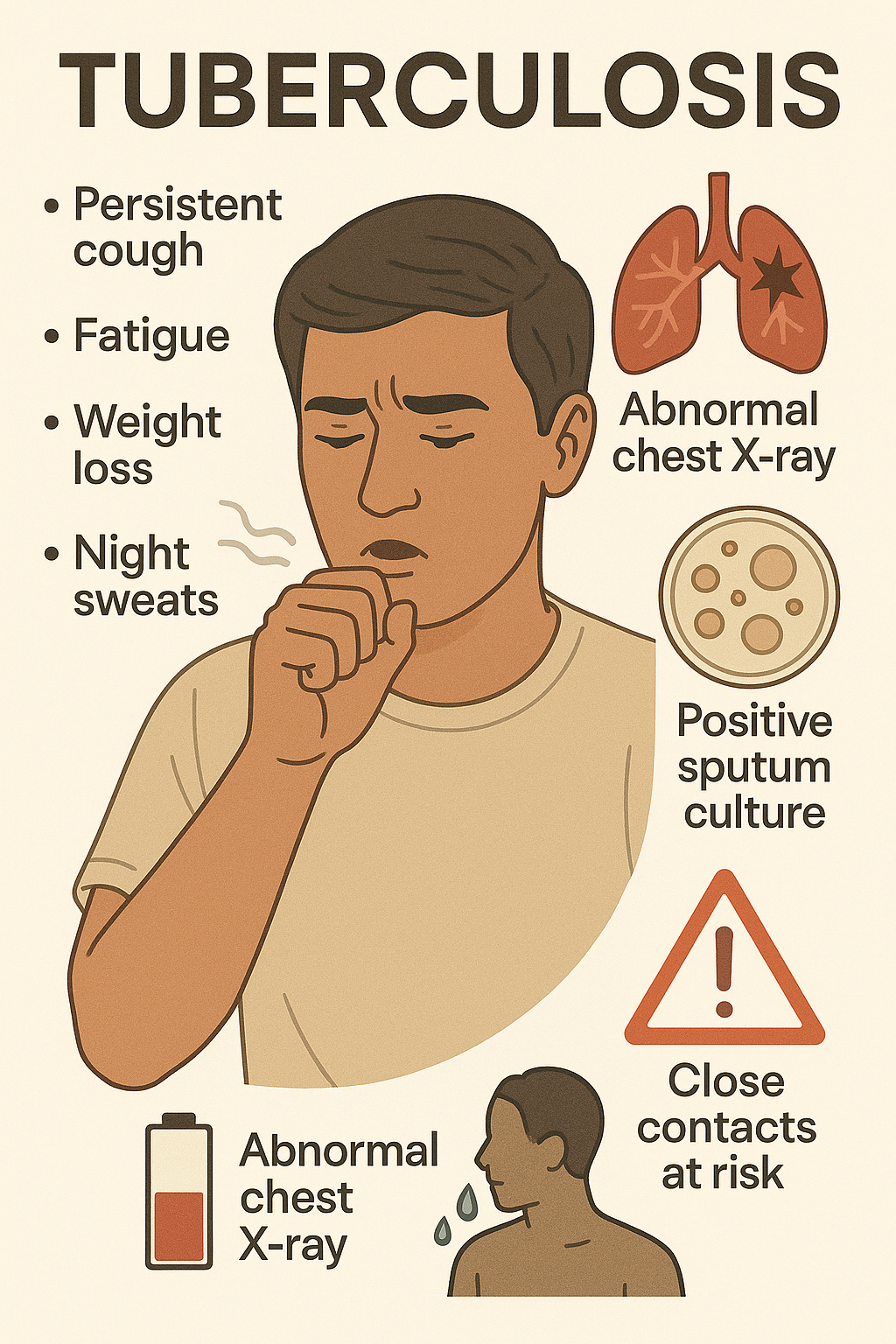5. Infection (Bacterial, Viral, Fungal, Tuberculosis)
 Definition
Definition
Respiratory infections involve inflammation of lung tissue due to pathogenic microorganisms, typically categorised as:
Bacterial (e.g. Streptococcus pneumoniae, Haemophilus influenzae)
Viral (e.g. Influenza, RSV, COVID-19)
Fungal (e.g. Aspergillus, Pneumocystis jirovecii)
Mycobacterial (Tuberculosis – Mycobacterium tuberculosis)
🛡️Causes (Aetiology)
Mnemonic: “B-FIT”
Bacterial – S. pneumoniae, H. influenzae, Legionella
Fungal – Aspergillosis, Pneumocystis jirovecii
Influenza viruses – Influenza A/B, RSV, COVID-19
Tuberculosis – M. tuberculosis (airborne)



📋 Risk Factors
🧠 Mnemonic: HOPE SCAR
HIV/immunosuppression
Overcrowding (TB)
Poor vaccination uptake
Elderly
Smoking
Chronic lung disease (e.g. COPD, asthma)
Alcoholism
Recent hospitalisation or travel
 Clinical Features
Clinical Features

Fever
Exertional dyspnoea
Vomiting/cough +/- sputum
Elevated CRP/WCC
Rales or crepitations on auscultation
Chest pain (pleuritic)
O2 desaturation
Productive cough (± purulent)
Shivering or rigors
 Examination Findings
Examination Findings
-
↓ Chest expansion
-
Dullness to percussion
-
Bronchial breathing or crackles
-
Tracheal deviation (TB cavity/effusion-related)
-
Lymphadenopathy (TB, fungal)
Investigations
| Level | Investigation | When to Use |
|---|---|---|
| 🟢 First-Line | CXR – consolidation, effusion, cavitation | All suspected pneumonia, TB, COVID, fungal infections |
| Bloods – FBC, CRP, U&Es, LFTs | Baseline and inflammatory markers | |
| O2 sats / ABG | Hypoxia, suspected respiratory failure | |
| Sputum culture | Moderate–severe infections or poor response to empiric therapy | |
| PCR (viral swab) | If viral infection suspected (COVID, flu, RSV) | |
| 🟡 Second-Line | Blood cultures | If sepsis suspected or severe pneumonia |
| Procalcitonin | Guide bacterial vs viral aetiology (esp. in hospital) | |
| Tuberculin skin test / IGRA | Suspected TB, especially latent or extrapulmonary | |
| HIV test | All cases of Pneumocystis jirovecii pneumonia or suspected immunosuppression | |
| 🔴 Specialist | HRCT Chest | Suspected fungal lung disease, unresolved pneumonia, cavitary lesions |
| Bronchoscopy + BAL | Immunocompromised, non-resolving pneumonia, suspected TB/fungal disease |
Severity Assessment (CAP Specific)
📊 CURB-65 Score – NICE NG138 (2023)
| Component | Criteria | Points |
| Confusion | AMT ≤8 | +1 |
| Urea | >7 mmol/L | +1 |
| Respiratory rate | ≥30 breaths/min | +1 |
| Blood pressure | Systolic <90 or Diastolic ≤60 | +1 |
| Age ≥65 | +1 |
Score Interpretation:
-
0–1: Home treatment
-
2: Hospital referral
-
≥3: Urgent hospital + consider ICU
Management
🧠 Mnemonic: ABC + PATH
Antibiotics – based on local guidelines & CURB-65
Barrier nursing for TB/COVID
Community vs Hospital admission decision (CURB-65)
Public Health notification (TB, COVID)
Anti-viral/fungal agents if indicated
Treat underlying immunodeficiency
Hydration, oxygen, and supportive care
📝 Example: TB Treatment
6-month RIPE: Rifampicin, Isoniazid, Pyrazinamide, Ethambutol (first 2 months)
Then Rifampicin + Isoniazid (4 months)

🧰 Summary Table for PARA Recall
| Infection Type | Key Organism | Key Clue | First-line Tx (Empirical) |
| CAP | Strep pneumoniae | Lobar consolidation | Amoxicillin (± clarithromycin) |
| HAP | Staph aureus, GNB | >48h in hospital | Piperacillin-tazobactam |
| TB | M. tuberculosis | Upper lobe, cavitation | RIPE: Rifampicin, Isoniazid, etc. |
| PCP | P. jirovecii | HIV, ↑LDH, ground-glass | Co-trimoxazole ± steroids |
| Aspergillosis | Aspergillus spp. | Cavities, immunocompromised | Voriconazole |
| COVID-19 | SARS-CoV-2 | PCR+, ground-glass CXR | Oxygen + dexamethasone ± abx |
Red Flags
Rapid deterioration
Sepsis/shock
Haemoptysis or cavitation
Multi-lobar involvement
Unresponsive to antibiotics after 48–72h
⚠️ Complications
Lung abscess
Empyema
Sepsis / ARDS
Cavitation (TB)
Bronchiectasis (post-infective)
Differential Diagnoses
PE
Lung cancer
Heart failure
Pneumothorax
Autoimmune ILD
✅ Review & Safety Netting
Always assess for deterioration: NEWS2
Escalate if CURB-65 ≥2 (hospital referral)
Contact tracing for TB
🔎 Last updated in line with:
NICE NG138 – Community-acquired pneumonia in adults
NICE NG33 – Tuberculosis
NICE NG186 – COVID-19 rapid guideline
NICE NG164 – Fungal infections: risk prediction and management in critically ill
Published: March 2020 • Last updated: May 2023
Last reviewed: July 2025
🔒 PASSMAP ensures all content is NICE-aligned and reviewed for Physician Associate Registration Assessment (PARA) success.
